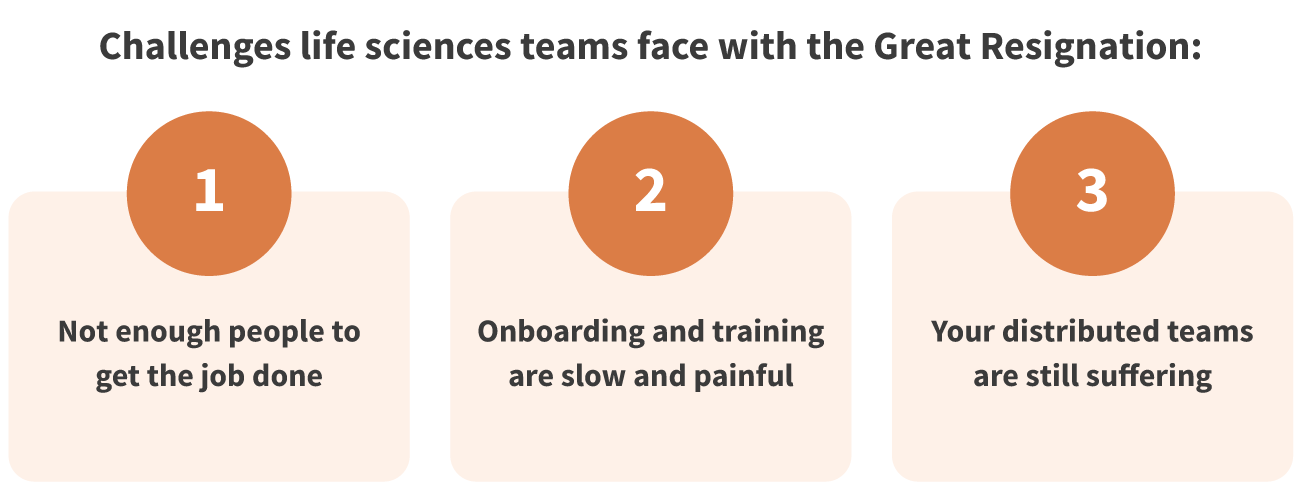Problem 1: Not enough people to get the job done
Throughout the Great Resignation, businesses have seen long-term employees with tons of institutional knowledge move on to retirement or other endeavors, and new employees have not necessarily replaced them.
This has hit content review teams hard. A detailed, cross-department endeavor like MLR review is complicated under the best of circumstances. When turnover removes individuals from the medical, legal, or regulatory departments, the processes that they hold together can quickly grind to a halt. An MLR review team can find itself waiting for a qualified person to be trained – or hired – before a document gets the expert eye it needs in a certain area. And if, to meet a deadline, a team pushes a piece through without adequate review, it could mean a fine from the FDA.
Solution: Expand productivity through technology
Implementing a document review solution that is built specifically for life sciences – one that can maintain audit trails, automate claim linkages, and streamline many of the things you might be doing manually – can make your processes far more efficient (and keep you safer in the event of an FDA audit). Processes that are more efficient from the outset will naturally be more efficient even in times of turnover.
Solution: Outsource talent through trusted partners
With MLR review becoming more specialized, intricate, and critical, some life sciences companies are succeeding by outsourcing the process to MLR review specialists.
By outsourcing MLR review to a partner, you don’t have to worry about hiring or replacing in-house MLR staff across departments. It also lets your medical, legal, and regulatory departments focus on their work without dedicating a point person to content review. And a good partner – which stakes its reputation on assuring accuracy and compliance – will be 100 percent focused on the task.
Problem 2: Onboarding and training are slow and painful
The Great Resignation may mean the departure of longtime staff pursuing new passions, but it also means a huge influx of eager new talent. You can see it as an exciting time to capitalize on and cultivate that energy.
Doing that takes time, though. And you’ve got deadlines!
Your content approval process needs to be fast and compliant. So when new talent comes in the door, you need to get them up to speed quickly to keep your content pipeline moving. While process slowdowns might seem inevitable when you have to onboard new staff, there are ways to drastically speed up onboarding.
Solution: Modernize your tools
You might have a piece of legacy, first-gen document review software as the centerpiece of your review process. Those tools aren’t always the most user friendly; the best content review suites are built with user experience in mind. Upgrading to a more intuitive document review solution makes it easier for new staff to start applying their expertise on day one. (Pepper Flow, by the way, has a demonstrated track record of turning complete novices into confident users with only 60 minutes of training.)
Remember when you’re choosing a new solution, though, that some charge for training. Per-user rates for onboarding and training can add up if turnover is high.
Solution: Create or revamp your SOPs and other training materials for content reviews
Having your process as organized as your tech stack is another key to improved productivity. Step-by-step Standard Operating Procedure (SOP) documents are key.
SOPs clearly lay out steps to common tasks. They minimize the risk of losing institutional knowledge when one person leaves, and make it easier for new members of a review team to pick up the job fast. They also help set clear expectations on performance and document turnaround.
If you have SOPs in place, it never hurts to reevaluate them to make sure they’re still accurate. If you’re launching a new content review solution, reevaluate SOPs and align them with the solution. Then, when you’re training new talent, you’re not just training them on general content review processes, but on specific ways to use the software – like configuring review workflows — to maximize their functionality.
As you’re building out your new or updated processes, check out our resources on effective communication during the review process and how to perfect the process from top to bottom.
Problem 3: Your distributed teams are still suffering
Two years into an all-WFH workplace, some life sciences companies may still be struggling to optimize their collaborative processes. Turnover makes it worse. Content review is multi-department, and with those departments never meeting face to face, wrapping document after document can be challenging.
Solution: Best practices for a remote MLR team
There are a number of best practices you can establish to let your distributed teams collaborate effectively, such as:
- Getting to the point: Communicating directly and unambiguously prevents simple miscommunications that can spiral into team frustration and costly inefficiency in a distributed environment.
- Talking things out: Letting potential concerns about process fester in the background can create frustration between teams. This is exacerbated when teams don’t see each other in person. Establishing a culture where people are comfortable voicing their concerns helps alleviate this.
- Setting expectations: In a distributed environment, clarity of deadlines, meeting times, deliverables, etc. is even more critical for MLR success than in an office.
- Getting MLR right in the new world of life sciences
Vodori is here to support you in this new world of working. We’re pioneering solutions that speak directly to life sciences companies’ review needs, and act as a trusted source of information and best practices.
Download our resource guide for even more ideas on how to maximize efficiency and employee satisfaction in an ever-changing, ever more challenging business landscape.



